The History Of SAAB
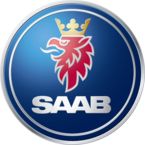
Saab Automobile AB, better known as Saab, is a Swedish car manufacturer and currently a wholly-owned subsidiary of General Motors. It is the exclusive automobile royal warrant holder as appointed by H.M., the King of Sweden. Since its inception, Saab has become known for turbocharging, “quirkiness”, safety and green technology.
Saab was originally created as a division of the Swedish Aeroplane Company (Svensk Aeroplan Aktiebolag in Swedish). The company had been established in 1937 for the express purpose of building aircraft for the Swedish Air Force. With World War II nearing its end, the company began looking for new markets in which to expand. In 1944, Project 92 began, with the goal of creating the first Saab passenger car. Five years later, the Saab 92 began production. The design highlighted the company’s roots in aviation. Notably, the car’s drag coefficient of 0.30 was the lowest of any production car at the time.[citation needed]
In 1955 the 92 was reworked and became the 93. The engine was upgraded from two to three cylinders but unusually remained a two stroke. The car received a facelift, including the first Saab with the brand’s trademark trapezoidal grille. A wagon variant, the 95, was added in 1959 and would remain in production for the next twenty years. The decade also saw Saab's first foray into true performance cars with the Saab 94, the first of four Saab Sonetts.
The need for a larger model saw the birth of the Saab 99 in 1967. The 99 was the final Saab designed by Sixten Sason, who had designed all their earlier models. Its design, a clean break from all earlier Saabs, would mark the brand's styling for the next twenty years. The 99 was also important in that it marked Saab's first turbocharged model.
In 1970, the 500,000th Saab was built. Six years later the 1,000,000th would follow.[citation needed]
Saab signed an agreement with Fiat in 1978 to sell a rebadged Lancia Delta as the Saab 600 and jointly develop a new car platform. The agreement yielded the Alfa Romeo 164, Fiat Croma, Lancia Thema and Saab 9000, all riding atop the Type Four chassis.
In 1987 the 2,000,000th Saab was manufactured.[citation needed] However, the company began to struggle and to cut costs, the Arlöv plant was closed, but heavy financial losses continued. On 15 March 1990, General Motors bought 50% of Saab for US $600 million, with an option to acquire the remaining shares within a decade. Despite this, losses continued and the Malmö plant was closed in 1991.
GM's involvement spurred the launch of the "new generation" Saab 900 in 1993. The new car used the same platform as the Opel Vectra and polarized Saab aficionados, but thanks to its sales, the company declared a profit in 1995 for the first time in seven years. In 2000, GM purchased the remaining shares of Saab, making the company a wholly-owned subsidiary.
In March 2005, it was announced that GM would move the production of the next-generation Saab 9-5 from Trollhättan to the Opel plant in Rüsselsheim, Germany in 2009. The Trollhättan factory now produces European Cadillacs. The next-generation Saab 9-3 is scheduled to be produced at Trollhättan.
Current models are the 9-3 and 9-5, both of which are manufactured in Trollhättan, Sweden and the Saab 9-7X SUV, manufactured in Moraine, Ohio. The Saab 9-2X, a rebadged Subaru Impreza that was manufactured in Japan, was discontinued after the 2006 model year.
A new crossover SUV, dubbed the 9-4X, will share a platform with the new Cadillac BRX and is expected to go on sale in 2010. It will be built in North America.
In December 2008, General Motors Corporation announced that Saab is "under review", which may also include the possible sale of the Swedish carmaker. BMW, Renault and Tata Motors have been reported as potential buyers.
Some of the early cars such as the two-strokers, V4s and Saab 99 were quite successful in rally sport, notably the 96 in the 1960s RAC Rally and Monte Carlo Rally, driven by Erik Carlsson.
- 1950 Saab enters two Saab 92s (chassis numbers 7 and 8) in the Monte Carlo Rally. One car is crewed by Rolf Mellde and K G Svedberg and Greta Molander and Margaretha von Essen compete in the other. Greta Molander comes in 55th overall, 5th in her class and 2nd in the Ladies Class. Rolf Mellde wins the Rikspokalen Rally in November, and Saab becomes the best marque team with Mellde, Svedberg and Greta Molander, who also wins the Ladies Class
- 1952 Greta Molander and Helga Lundberg win the Ladies Cup in the Monte Carlo Rally.
- 1953 Rolf Mellde wins the Swedish Rally Championship.
- 1955 Mellde rolls his Saab 92, but still manages to win the Rikspokalen Rally.
- 1956 Bob Wehman and Louis Braun win the Great American Mountain Rally. Rolf Mellde comes sixth and another Saab 93 finishes in seventh place.
- 1959 Two Saab 93s are entered in the Le Mans 24 Hours. The car driven by Sture Nottorp and Gunnar Bengtsson come in 12th overall and second in its class. The same year Erik Carlsson wins the Midnight Sun Rally.
- 1960 Erik Carlsson wins the RAC Rally and Saab start competing in Formula Junior with the Saab Formula Junior.
- 1961 Erik Carlsson enters the Monte Carlo Rally in a Saab 95 and finishes fourth, and wins the RAC Rally for the second successive year.
- 1962 Erik Carlsson and Gunnar Häggbom win the Monte Carlo Rally, and completes a hat-trick of RAC Rally wins.
- 1963 Erik Carlsson again wins the Monte Carlo Rally, this time with Gunnar Palm as co-driver. They also finish second in the Spa-Sofia-Liège Marathon de la Route.
- 1968 Finn Simo Lampinen wins the RAC Rally in a Saab 96V4.
- 1971 Stig Blomqvist wins the Swedish and RAC Rallies in a Saab 96V4. Erik Carlsson retires from rallying and become Saab ambassador.
- 1976 Stig Blomqvist wins the Belgian Boucles de Spa Rally in a Saab 99 EMS.
- 1977 Stig Blomqvist wins the Swedish Rally in a Saab 99 EMS.
- 1979 Stig Blomqvist wins the Swedish Rally in a Saab 99 Turbo. This is the first time a turbocharged car has won a World Championship Rally event.
- 1980 Saab withdraws from all competition activities citing reasons of cost, and because it cannot compete with 'prototype' vehicles using its production-based cars. Being a small manufacturer, SAAB could not afford to build special a "Homologation Special" like the Ford RS200 and Lancia Stratos. These Group B competition cars had evolved so they had very little in common with production cars and thus were of no value to production car development. A number of personnel from the competition department branch out and start Trollspeed aimed at producing competition upgrades for Saabs.
- 2000 Saab returns to competition by sponsoring Swede Team Motor who compete with a Saab 9-3 Aero SportSedan, a Saab 9-3 Coupe and a 1964 two-stroke Saab 96. The return to competition was to attract students to the auto-mechanic educations. The students get to work on the race cars before, during and after races to expand the students' knowledge and quality awareness.
- 1958: The GT 750 is the first car fitted with headrests as standard.
- 1963: Saab becomes the first volume maker to offer diagonally-split dual brake circuits.
- 1969: Saab creates an ignition system near the gearbox, instead of behind the steering wheel like most cars.
- 1970: Saab introduces a 'world-first' - headlamp wipers and washers.
- 1971: Heated front seats are introduced, the first time in the world they are fitted as standard.
- 1971: Saab develops the impact-absorbing, self-repairing bumper.
- 1976: Saab was the first manufacturer to produce a turbo engine with wastegate to control boost.
- 1978: Saab introduces another 'world-first,' the passenger compartment air filter (pollen filter).
- 1980: Saab introduces Automatic Performance Control (APC), and an anti-knock sensor that allowed higher fuel economy and the use of lower grade fuel without engine damage.
- 1981: Saab introduces the split-field side mirror. This eliminates the drivers blind spot.
- 1982: Saab introduces asbestos-free brake pads.
- 1983: Saab introduces the 16-valve turbocharged engine
- 1985: Saab pioneers direct ignition, eliminating the distributor and spark plug wires.
- 1991: Saab introduces a 'light-pressure' turbo.
- 1991: Saab is the first manufacturer to offer CFC-free air-conditioning.
- 1991: Saab develops its 'Trionic' engine management system, equipped with a 32-bit micro-processor.
- 1993: Saab introduces the 'Sensonic clutch' and the 'Black Panel', later to be called the 'Night Panel'.
- 1993: Saab develops the 'Safeseat' rear passenger protection system.
- 1994: Saab introduces the 'Trionic T5.5' engine management system, its processor is a Motorola 68332.
- 1995: Saab presents an asymmetrically turbocharged V6 at the Motor Show in Frankfurt, Germany.
- 1996: Saab introduces active head restraints (SAHR), which help minimize the risk of whiplash.
- 1997: Saab introduces Electronic Brake-force Distribution
- 1997: Saab fits ventilated front seats to their new 9-5.
- 1997: Saab introduces ComSense; an alert delay feature that reduces the risk of distraction by briefly postponing lower priority alerts when the brakes or indicators are activated
- 2000: Saab introduces Saab Variable Compression
- 2002: Saab developed ReAxs System provides crisp steering feedback and contributes to enhanced driving stability in curves
- 2003: Saab introduces CargoSET; automatic storage well retraction for the convertible, a two-step tonneau action for quicker soft-top deployment
- 2008: Saab introduces Cross-wheel drive, an advanced all-wheel drive system with eLSD.
- Saab cars are subjected to the moose test (aka elk test).
- The first Saab, Saab 92, was hand-hammered into shape by using a support that consisted of an oak stump placed on top of a pile of horse-dung[citation needed]. Using the horse-dung support, the craftsman could get the correct response.
- In order to increase production volume, Saab helped Valmet Automotive to start a car factory in Uusikaupunki (Nystad), Finland. Since 2003, Saab no longer manufactures any cars in Finland as the production of the 9-3 Convertible was moved to Graz, Austria.
- A common feature of Saab car types is the use of the number 9 in the model numbers. Current models are the 9-3 and 9-5, both which are manufactured in Trollhättan, Sweden, and 9-7X, which is manufactured by General Motors. The exception to this naming rule is the Saab 600, which was a rebadged Lancia Delta.
- All modern Saabs (except the 9000 and 9-2X) have a floor-mounted ignition. This is for many reasons, some of which follow: Saab believes this is a safer position in case of an accident. The driver's knee often jerks upward in a collision; the compact and dense ignition module on the steering column of many other cars has shattered many kneecaps. Saabs have bolstered dashboards for both front seat occupants. Also, the floor-mounted position yields more space, allowing modern Saabs to have a metal bar that rotates over and up into the ignition when the key is turned to the "Lock" position. This makes Saabs very challenging to hotwire. Ergonomically, the ignition's location next to the parking brake lever, gearshift, and seatbelt, saves time as all motions associated with startup fall right at hand and become second nature. Last of all, the ignition is located on the floor because, in the airplanes that inspired Saab automobiles, the throttle controls were all located on the floor. Originally Saabs also had the key located on the right side of the steering column, but when they changed from a column shifter to a floor shifter, the ignition key followed along, except in the Sonett III and 9000.
- In 1986 the Saab Long Run took place. Three standard Saab 9000 Turbos set 2 world records and 21 international records at the Talladega Superspeedway in Talladega, Alabama, USA. 100,000 km (62,137 miles) were covered with an average speed of 213.299 km/ h (132.537 mph) and 50,000 miles (80,467 km) with an average speed of 213.686 km/ h (132.778 mph).
- Ten years later, in 1996, three standard Saab 900 (NG) Turbos driven by factory test drivers and two standard naturally aspirated Saab 900s driven by journalists set new world records on the same speedway.
- In 1987, Saab created a TV advertisement called "Saab suite" (subtitled Ballet in 3 acts for 8 Saab 9000 Turbos). In the film, stunt drivers show incredible driving with stock cars, such as one-wheeled burnouts, bumper-to-bumper driving through a slalom, cars slaloming from opposite directions on the same course, two-wheel driving, sliding in full speed, and jumping over passing cars—all on a closed airport runway with classical music playing in the background. Click Here to view the video.
- To commemorate its 40th anniversary, Saab formed a Performance Team in 1987, which laid on exhibitions of automobile acrobatics and formation driving. Initially this was done with Saab 9000s, as above, then later models, such as the Saab 900 (NG) were used. All of the team's members have previously competed in rallies, but what's unusual is that all 5 Performance Team members hold regular jobs at Saab: there are two engineers, a quality controller, a technician and the head of Saab's photo studio. The picture shows these vehicles on display at the Diamond Jubilee celebrations of the Saab Aircraft Company, at Linköping, in 1997. Click here to view one of their videos
- Dating back to 1937, Svenska Aeroplan AB (SAAB) created airplanes, introducing their first car, the Saab 92001, in 1947. Currently, Saab AB is separate from Saab Automobile (which is owned by General Motors), and is probably best known for its Saab 37 Viggen (the Viggen badge would be shared by a 9-3). This has led to the current ad campaign, "Born From Jets," evoking the days when Saab produced both aircraft and automobiles.
- In early December 2006, a Wisconsin traveling salesman donated his 1989 Saab 900 SPG (Special Performance Group) to the Wisconsin Automotive Museum after amassing 1,001,385miles (1,611,573km) on the original factory engine. This mileage was verified by Saab.
- Saab have compiled a database where they have analysed more than 6.100 real-life accidents with Saabs. The first recorded event was in 1948 where a Saab test had an accident.
- The Saab 900 Turbo was James Bond's vehicle of choice in many of the John Gardner Bond novels of the 1980s, beginning with Licence Renewed. In the second novel, For Special Services, the 900 was dubbed the "Silver Beast". The car is Bond's private vehicle that he had outfitted with various gadgets by the real-life company Communication Control Systems, Ltd. (CCS). In conjunction with the release of Licence Renewed, Saab had a real "Silver Beast" created that was virtually identical to the specifications in the book. The car is currently located at the Saab Museum in Trollhättan, Sweden.
- In an essay originally published in In These Times in November, 2004 entitled Have I Got A Car For You, writer Kurt Vonnegut recounts his experiences as the owner/ operator of a Saab dealership in West Barnstable, Massachusetts and humorously claims that his criticism of Swedish engineering is the reason he was never awarded a Nobel Prize in Literature. The essay also appeared in the 2005 anthology A Man Without A Country.
- A Hewlett-Packard CPU-support chip features a Saab 900 Turbo 16 Cabriolet etched into its structure.
- The Australian band 78 Saab derived its name from the Saab marque.
- Popular songs inspired by Saabs include "Ireland" by Tori Amos and "Djungeltrumman" by Michael Tretow.
Saab's total world production in 2007 was 136,925 vehicles produced in 2 countries.
Current models
- Saab 9-3 (1998 – present)
- Saab Turbo X (2008)
- Saab 9-5 (1997 – present)
- Saab 9-7X (2005 – 2008)
Future models
- Saab 9-4X (2009 – onwards)
Historical models
- Saab 92 and descendents:
- Saab 92 (1949 – 1956)
- Saab 93 (1955 – 1960)
- Saab GT750 (1958 – 1960)
- Saab 94 Sonnet I (1956)
- Saab 95 estate car (1959 – 1978)
- Saab 95 3 cylinder two-stroke (1960 – 1967)
- Saab 95 V4 (1967 – 1980)
- Saab 96 (1960 – 1980)
- Saab 96 3 cylinder two-stroke (1960 – 1968)
- Saab Sport 3 cylinder two-stroke (1962 – 1966)
- Saab Monte Carlo 850 3 cylinder two-stroke (1966 - 1967)
- Saab 96 V4 (1967 – 1980)
- Saab Monte Carlo V4 V4 (1967 - 1968)
- Saab 97
- Sonnet II (1966 – 1970)
- Sonnet III (1970 – 1974)
- Saab Formula Junior single seat racing car (1960)
- Saabo caravan/ camper/ travel trailer (1964 – 1968)
- Saab 99 and descendents:
- Saab 99 (1968 – 1984)
- Saab 900 "Classic" (1979 – 1994)
- Saab 90 (1984 – 1987)
- Saab 600 (1985 – 1988)
- Saab 9000 (1985 – 1998)
- Saab 900 "New Generation" (1994 – 1998)
- Saab 9-2X (2004 – 2006)
Concepts and prototypes
- Saab 92 line:
- Saab 92001 or Ursaab the prototype for the first Saab production car (1946)
- Saab Monster (1959)
- Saab 60 (1962)
- Saab Quantum (1962)
- Saab Catherina (1964)
- Saab MFI13 (1965)
- Saab Toad (1966)
- Saab 98 (1974)
- Saab EV-1 (1985)
- Saab 9XX Concept (1991)
- Saab 9-X (2001)
- Saab 9-3X (2002)
- Saab 9-3 SportHatch (2003)
- Saab 9-5 Aero BioPower (2006)
- Saab Aero-X (2006)
- Saab 9-4X BioPower (2008)
- Saab 9-X BioHybrid (2008)
- Saab 9X Air (2008)
From Wikipedia, the free encyclopedia
More About SAAB
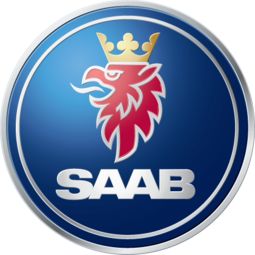
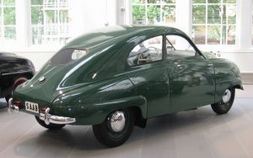
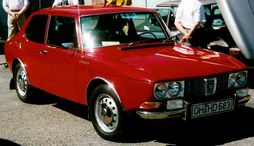
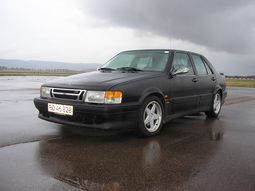
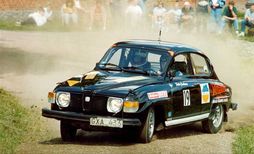
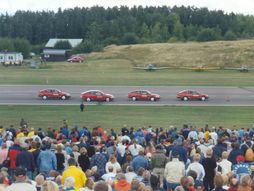
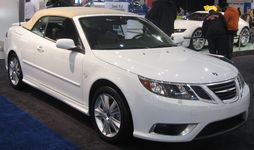
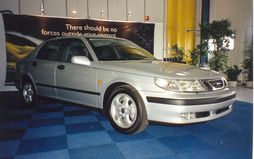
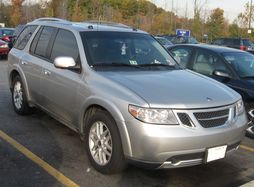
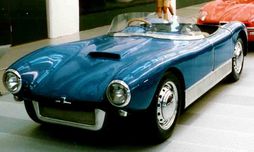
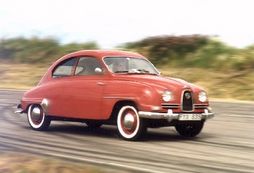
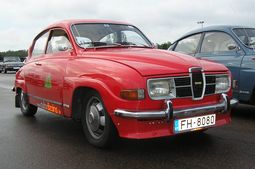
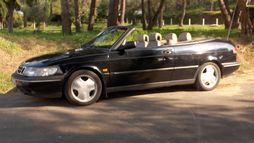
|